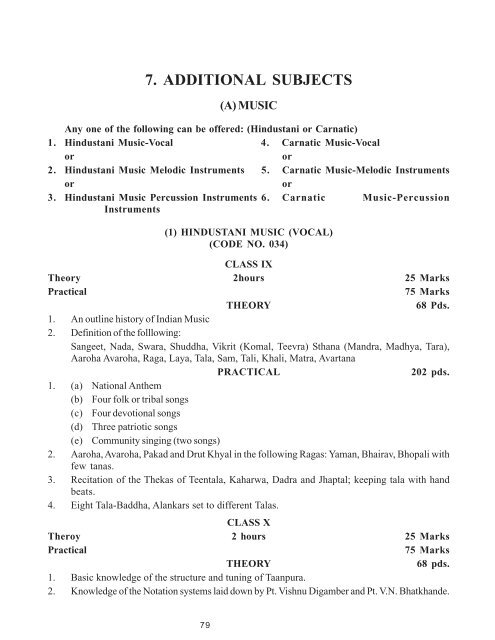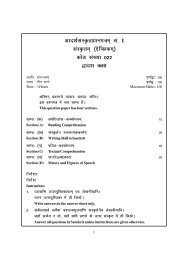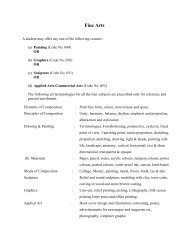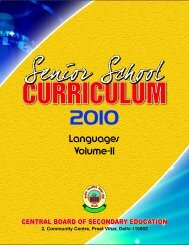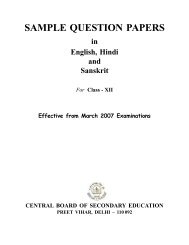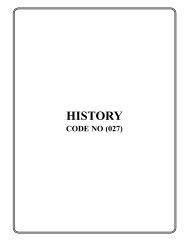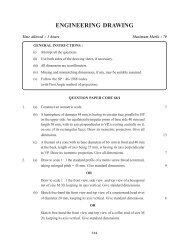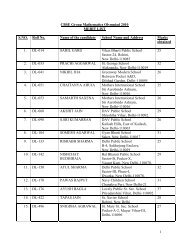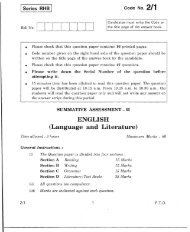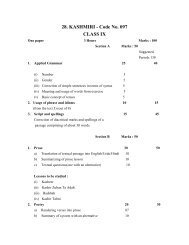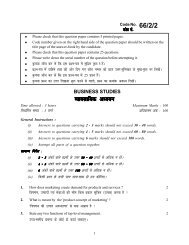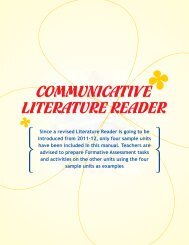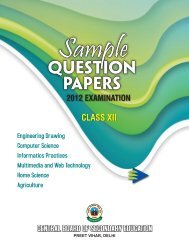7. ADDITIONAL SUBJECTS - Central Board of Secondary Education
7. ADDITIONAL SUBJECTS - Central Board of Secondary Education
7. ADDITIONAL SUBJECTS - Central Board of Secondary Education
You also want an ePaper? Increase the reach of your titles
YUMPU automatically turns print PDFs into web optimized ePapers that Google loves.
<strong>7.</strong> <strong>ADDITIONAL</strong> <strong>SUBJECTS</strong><br />
79<br />
(A) MUSIC<br />
Any one <strong>of</strong> the following can be <strong>of</strong>fered: (Hindustani or Carnatic)<br />
1. Hindustani Music-Vocal 4. Carnatic Music-Vocal<br />
or or<br />
2. Hindustani Music Melodic Instruments 5. Carnatic Music-Melodic Instruments<br />
or or<br />
3. Hindustani Music Percussion Instruments 6. Carnatic Music-Percussion<br />
Instruments<br />
(1) HINDUSTANI MUSIC (VOCAL)<br />
(CODE NO. 034)<br />
CLASS IX<br />
Theory 2hours 25 Marks<br />
Practical 75 Marks<br />
THEORY 68 Pds.<br />
1. An outline history <strong>of</strong> Indian Music<br />
2. Definition <strong>of</strong> the folllowing:<br />
Sangeet, Nada, Swara, Shuddha, Vikrit (Komal, Teevra) Sthana (Mandra, Madhya, Tara),<br />
Aaroha Avaroha, Raga, Laya, Tala, Sam, Tali, Khali, Matra, Avartana<br />
PRACTICAL 202 pds.<br />
1. (a) National Anthem<br />
(b) Four folk or tribal songs<br />
(c) Four devotional songs<br />
(d) Three patriotic songs<br />
(e) Community singing (two songs)<br />
2. Aaroha, Avaroha, Pakad and Drut Khyal in the following Ragas: Yaman, Bhairav, Bhopali with<br />
few tanas.<br />
3. Recitation <strong>of</strong> the Thekas <strong>of</strong> Teentala, Kaharwa, Dadra and Jhaptal; keeping tala with hand<br />
beats.<br />
4. Eight Tala-Baddha, Alankars set to different Talas.<br />
CLASS X<br />
Theroy 2 hours 25 Marks<br />
Practical 75 Marks<br />
THEORY 68 pds.<br />
1. Basic knowledge <strong>of</strong> the structure and tuning <strong>of</strong> Taanpura.<br />
2. Knowledge <strong>of</strong> the Notation systems laid down by Pt. Vishnu Digamber and Pt. V.N. Bhatkhande.
3. Definition <strong>of</strong> Vadi, Samvadi, Anuvadi, Vivadi, Alap<br />
4. Brief description <strong>of</strong> Natya shastra, Sangeet Ratnakar.<br />
PRACTICAL 202 PDS.<br />
1. Community Singing:<br />
(a) Two songs in different regional languages.<br />
(b) One Tagore song<br />
2. Aaroha, Avaroha, Pakad and Drut Khyal in the following Ragas: Kafi, Khamaj, Sarang and<br />
Desh with simple elaborations and few tanas.<br />
Suggested Reference Books :<br />
1. Kramik Pustak Malika by Pandi V.N. Bhatkhande<br />
2. Rag Vigyan by Pandi V.N. Patwardhan.<br />
Theory<br />
(II) HINDUSTANI MUSIC (MELODIC INSTRUMENTS)<br />
(Code No. 035)<br />
CLASS IX<br />
2 hours 25 Marks<br />
Practical 75 Marks<br />
THEORY 68 PDS.<br />
1. An outline history <strong>of</strong> Indian Music<br />
2. Definition <strong>of</strong> the following:<br />
Sangeet, Nada, Swara, Shuddha, Vikrit (Komal, Teevra) Sthana (Mandra, Madhya, Tara),<br />
Aaroha Avaroha, Raga, Laya, Tala, Sama, Tali, Khali, Matras, Avartana.<br />
PRACTICAL 202 pds.<br />
1. Pr<strong>of</strong>iciency in any one <strong>of</strong> the following instruments :<br />
(i) Sitar, (ii) Sarod, (iii) Violin, (iv) Dilruba or Esraj (v) Flute (vi) Mandolin, (vii) Guitar.<br />
2. (a) The tune <strong>of</strong> National Anthem.<br />
(b) Four light Dhuns and four folk dhuns <strong>of</strong> different regions.<br />
3. Aaroha, Avaroha, Pakad and Drut gat in the following Ragas; Yaman Bhairav, Bhopali with<br />
few Todas.<br />
4. The recitation <strong>of</strong> Thekas <strong>of</strong> Teen Taal, Keharwa, Dadra and Jhaptal, taal keeping with hand<br />
beats.<br />
CLASS X<br />
Theory 2 hours 25 Marks<br />
Practical 75 Marks<br />
THEORY 68 pds<br />
1. Basic knowledge <strong>of</strong> the structure and tuning <strong>of</strong> any one <strong>of</strong> the following insruments:<br />
(i) Sitar, (ii) Sarod, (iii) Violin, (iv) Dilruba or Esraj, (v) Flute, (vi) Mandolin, (vii) Guitar.<br />
80
2. Knowledge <strong>of</strong> the Notation systems laid down by Pt. Vishnu Digamber Paluskar and Pt. V.N.<br />
Bhatkhande.<br />
3. Vadi, Samvadi, Anuvadi, Vivdi, Alap<br />
4. Brief description <strong>of</strong> Natya Shastra, Sangeet Ratnakar.<br />
PRACTICAL 202 pds.<br />
1. Eight Tala-babbha Alankaras set to different Talas.<br />
2. Aaroha, Avaroha, Pakad and Drut gat in the following Ragas: Kafi, Khamaj, Sarang and Desh<br />
with simple elaborations and few Todas<br />
Suggested Reference Books:<br />
1. Sitar Marg (I Part) by Shri S. Bandyopadhyaya, Vani Mandir, Subzi Mandi, Delhi-7<br />
2. Vitat Vadya Shiksha’, by Shri S. Bandyopadhyaya, Vani Mandir, Subzi Mandi, Delhi-7<br />
3. Sitar and its Technique by Pr<strong>of</strong>. Debu Chaudhuri, Avon Publishers, Shahdara, Delhi.<br />
(III) HINDUSTANI MUSIC (PERCUSSION-INSTRUMENTS)<br />
(CODE NO. 036)<br />
CLASS IX<br />
Theory 2 hours 25 Marks<br />
Practical 75 Marks<br />
THEORY 68 pds<br />
1. An outline history <strong>of</strong> Indian Music<br />
2. Definition <strong>of</strong> the following:<br />
Sangeet, Nada, Swara, Shuddha, Vikrit (Komal, Teevra) Rga, Laya, Tala, Matra, Vibhag, Sama,<br />
Tali Avartana, Dugun, Tigun, Chaugun.<br />
PRACTICAL 202 pds.<br />
To acquire efficiency in playing on the opted percussion instrument (Tabla or Pakhawaj) with<br />
special referene to accompaniment.<br />
1. Ability to recite with hand beats and to play on the instruments the Theka <strong>of</strong> Teen Taal, Kaharwa,<br />
Dadra, with simple elaborations.<br />
2. Accompaniment with solo performance.<br />
CLASS X<br />
Theory 2 hours 25 Marks<br />
Practical 75 Marks<br />
THEORY 68pds.<br />
1. Basic knowledge <strong>of</strong> the structure and tuning <strong>of</strong> the instruments (Tabla or Pakhawaj).<br />
2. Knowledge <strong>of</strong> the Notation systems laid down by Pt. Vishnu Digamber Paluskar and Pt. V.N.<br />
Bhatkhande.<br />
3. Definition <strong>of</strong> Avartan, Theka, Lahera, Amad, Mohra, Tihai.<br />
81
4. Brief description <strong>of</strong> Natya Shastra, Sangeet Ratnakar.<br />
PRACTICAL 202 pds.<br />
1. To produce correctly the basic Bolas-Ta, Dha, Tin and Dhin, Dha, Ki, Na, Ti, Dhi, Na and Ti; Ti,<br />
Na, Dhi, Dhi, Ga, Tir, Kit, Tu, Na, Katta, etc.<br />
2. Ability to recongise the tala <strong>of</strong> the composition being sung or played on a melodic instrument.<br />
3. To recite the tala with hand beats and to play on the instrument the Theka <strong>of</strong> Jhaptala, Rupak<br />
and Ektala with elaborations.<br />
Suggested Reference Books :<br />
1. ‘Tal Sastra’ by Shri Bhagwat Sharan, Sangit Hathras.<br />
2. Tabla Vadan Shiksha by Pt. Krishna Rao Shankar Pandit.<br />
(IV) CRNATIC MUSIC (VOCAL)<br />
(CODE NO. 031)<br />
CLASS IX<br />
Theory 2 hours 25 Marks<br />
Practical 75 Marks<br />
THEORY 68 pds.<br />
1. Knowledge <strong>of</strong> the following terms:<br />
Sangita, Naada, Swara, Svarsthana, Arohana, Avarohana, Sruti, Taala, Laya, Alankara, Sthayi,<br />
Graha or Eduppu, Dhaatu, Maatu or Degrees <strong>of</strong> Speed, Anya Svara, Suddha Svara, Vikrta,<br />
Svara Sangati, Poorvaanga, Uttaranga, Vaadi Samvaadi, Anuvaadi, Vivaadi, Samam, Atita,<br />
Anaagata, Raaga<br />
2. Outlines <strong>of</strong> Raaga, Lakshanaas <strong>of</strong> the following:<br />
Maayaamaalavagowla, Sankaraabharanam, Kharaharapriya, Hamsadhvani.<br />
3. Lakshanaas <strong>of</strong> the following musical forms:<br />
Gitam, Svarajati, Varnam.<br />
4. Basic knowledge <strong>of</strong> the following Taalas:<br />
Aadi Roopakam, Chaapu.<br />
5. An outline history <strong>of</strong> Indian Music, including the biography <strong>of</strong> Purandaradaasa and Tyaagaraaja.<br />
PRACTICAL 202 pds.<br />
1. Community Singing:<br />
(a) National Anthem<br />
(b) Five folk or tribal songs <strong>of</strong> any region indicating time <strong>of</strong> the year and occasion with which<br />
they are related.<br />
2. Voice-culture exercises for Sruti Suddha and Sthana Suddha<br />
3. The following ragas with descriptive details:<br />
Maayaamaalavagowla, Sankaraabharanam, Kharaharapriya, Hamsadhvani<br />
82
4. Singing <strong>of</strong> simple, Devernaamaas and Tiru Pugazh to the accompaniment <strong>of</strong> Tambura and<br />
Mridangam.<br />
5. Soolaadi Sapta Talas and Chaapu Talas.<br />
Suggested Referene Books:<br />
South Indian Music Publishing Home: Volumes I, II, III & IV by Pr<strong>of</strong>. P. Sambamoorthy.<br />
CLASS X<br />
Theory 2 hours 25 Marks<br />
Practical 75 Marks<br />
THEORY 68 pds.<br />
1. Raaga Lakshana outlines <strong>of</strong> the following:<br />
Mohanam, Kalyaani, Kaambhoji, Bhairavi.<br />
2. Lakshanas <strong>of</strong> Keertana and Kriti<br />
3. Outlines knowledge <strong>of</strong> the seventy-two Melakarta Scheme<br />
4. Basic Knowledge <strong>of</strong> the structure and tuning <strong>of</strong> the Tambura.<br />
5. Principles <strong>of</strong> Notation in Karnataka music.<br />
PRACTICAL 202 pds.<br />
1. Community Singing:<br />
Four devotional songs, simple Naamaavalis, Bhajans composed by the saints/poets <strong>of</strong> India.<br />
2. The following ragas with descriptive details:<br />
Mohanam, Kalyaani, Kaambhoji, Bhairavi.<br />
3. To create proper sense <strong>of</strong> svara and laya through sapta tala alankaaras. Alankaaras in<br />
Moyaamaalava gowla and other simple scales.<br />
4. Divyanaama keertanas and simple kritis, to the accompaniment <strong>of</strong> Tambura and Mridangam.<br />
5. Principles <strong>of</strong> notation in Carnatic music, illustrated with suitable examples.<br />
(V) CARNATIC MUSIC (MELODIC INSTRUMENTS)<br />
(CODE NO. 032)<br />
CLASS IX<br />
Theory 2 hours 25 Marks<br />
Practical 75 Marks<br />
THEORY 68 pds.<br />
1. Knowledge <strong>of</strong> the following terms :<br />
Sangita, Naada, Swara, Svarsthana, Arohana, Avarhana, Aavarta, Sruti, Sthayi, Graha or Eduppu,<br />
Dhaatu, Maatum Sama, Kaala <strong>of</strong> Degrees <strong>of</strong> Speed, Suddha Svara Vikrta, Svara, Sangati<br />
Poorvaanga, Uttaranga, Vaadi, Samvaadi, Anuvaadi, Vivaadi, Atita, Anaagata, Anya svara.<br />
2. Raaga, Lakshanaas Outlines <strong>of</strong> :<br />
Maayaamaalavogowla, Sankaraabharanam, Kharaharapriya, Hamsadhvani.<br />
3. Lakshanaas <strong>of</strong> the musical forms geetam, svarajati and Varnam.<br />
83
4. Taalas : Aadi, Roopakam and Chaapu.<br />
5. An outlines history <strong>of</strong> Indian Music including the biography <strong>of</strong> Purandaradaasa and Tyaagaraaja.<br />
PRACTICAL 202 pds.<br />
1. Any one <strong>of</strong> the following instruments :<br />
1. Veena 2.Violin 3. Flute 4. Gottuvadyam<br />
2. The candidates for instruments may be allowed to opt for community singing or for instrumental<br />
ensemble based either on the ragas from the syllabus or light and folk melodies.<br />
3. Sapta Tala Alankaras in simple scales.<br />
4. Playing ragas in detail on the instrument as prescribed in Theory.<br />
5. Musical compositions :<br />
Two geetams, one svarajati and one Adi Tala Varnam in two degrees <strong>of</strong> speed.<br />
CLASS X<br />
Theory 2 hours 25 Marks<br />
Practical 75 Marks<br />
THEORY 68 pds.<br />
1. Basic knowledge <strong>of</strong> the structure and tuning <strong>of</strong> the instrument opted for<br />
2. Outline knowledge <strong>of</strong> the seventy-two Melakarta Scheme.<br />
3. Prinicples <strong>of</strong> Notation in Karnataka music.<br />
4. Raaga Lakshana <strong>of</strong> Mohanam, Kalyaani, Kaambhoji, Bhariavi.<br />
5. Lakshanas <strong>of</strong> the musical forms keertanam and Kriti.<br />
PRACTICAL 202 pds.<br />
1. Playing <strong>of</strong> the ragas prescribed for Theory<br />
2. Tuning the instrument<br />
3. Musical composition : Ata tala Varnam in two degrees <strong>of</strong> speed.<br />
4. Simple keertanams and simple kritis.<br />
Suggested Reference Books:<br />
1. Flute by Pr<strong>of</strong>. Sambamoorthy.<br />
2. Musical Instrument <strong>of</strong> India by S. Krishnaswamay.<br />
(VI) CARNATIC MUSIC (PERCUSSION-INSTRUMENTS)<br />
(CODE NO. 033)<br />
CLASS IX<br />
Theory 2 hours 25 Marks<br />
Practical 75 Marks<br />
THEORY 68 pds.<br />
1. Knowledge <strong>of</strong> the following terms:<br />
Sangita, Naada, Swara, Svarasthana, Arohana, Avarohana, Aavarta, Sruti, Sthayi, Graha or<br />
84
Eduppu, Dhaatu, Maatu, Sama, Kaala or Degrees <strong>of</strong> Speed, Suddha Svara Vikrta, Svara,<br />
Sangati, Poorvaanga, Uttaranga, Vaadi, Samvaadi, Anuvaadi, Vivaadi, Atita, Anaagata, Anya<br />
Svara.<br />
2. Raaga, Laksanaas Outlines <strong>of</strong> :<br />
Maayaamaalavagowla, Sankaraabharanam, Kharaharapriya, Hamsadhvani.<br />
3. Lakshanaas <strong>of</strong> the musical forms geetam, Svarajati and Varnam.<br />
4. Taalas : Aadi, Roopakam and Chaapu.<br />
5. An outline history <strong>of</strong> India Music including the biography <strong>of</strong> Purandaradaasa and Tyaagaraaja<br />
PRACTICAL 202 pds.<br />
1. To acquire pr<strong>of</strong>iciency in playing on the Mridangam both for Solo and Accompanying purposes.<br />
Also to learn to handle a few other percussion instruments, such as the Ghatam, the Kanjeera<br />
and the Moresing.<br />
1. To participate in community singing<br />
2. Stress to be laid on creating and developing proper sense <strong>of</strong> rhythm.<br />
3. To recite “Sollukattus” for the different taalas.<br />
CLASS X<br />
Theory 2 hours 25 Marks<br />
Practical 75 Marks<br />
THEORY 68 pds.<br />
1. Knowledge <strong>of</strong> the structure and tuning <strong>of</strong> the instrument<br />
2. To produce correctly and clearly the Sollukattus on the instrument opted for the technicalities<br />
related to them.<br />
3. Principles <strong>of</strong> Notation in Karnataka music<br />
4. Lakshanas <strong>of</strong> the musical forms keertanam and Kriti, also ragas Mohanam, Kalyaani, Kaambhoji,<br />
Bhairavi.<br />
5. Basic knowledge <strong>of</strong> the principles <strong>of</strong> performance as presented in Vocal and Instrumental<br />
music.<br />
PRACTICAL 202 pds.<br />
1. To play precisely, the Sollukattus in different degrees <strong>of</strong> speed.<br />
2. Tuning <strong>of</strong> the instrument.<br />
3. Ability to play the Thekas and Mohras in Adi tala, Rupaka tala and Chaappu talas.<br />
4. To play brief toni-aavartams in simple taalas.<br />
Suggested Reference Books :<br />
1. ‘Percussion Instruments & Laya Vadys’ Pr<strong>of</strong>. P. Sambamurti.<br />
2. ‘Mridanga Svabodhini’ by M.R. Durairaj<br />
85
(B) PAINTING<br />
(CODE NO. 049)<br />
CLASS IX<br />
One paper 3 hours 100 Marks 270 Periods<br />
(i) Still Life Study 50 190<br />
Study <strong>of</strong> a group <strong>of</strong> two or three arranged objects from<br />
a fixed point <strong>of</strong> view in colour. Group may include, vegetables,<br />
foliage and objects <strong>of</strong> daily use.<br />
(ii) Sketches from Life and Nature in Pencil and Ink. 20 80<br />
(iii) Submission <strong>of</strong> portfolio consisting <strong>of</strong> five selected works 30<br />
done during the year.<br />
CLASS X<br />
One paper 3 hours 100 Marks 270 Periods<br />
Painting from Memory<br />
Simple composition in (water/poster/pastel) colours on given subjects based on sketching from<br />
life,<br />
(C) COMMERCE<br />
Note : Any one <strong>of</strong> the following three areas can be <strong>of</strong>fered:<br />
I. Elements <strong>of</strong> Business<br />
Or<br />
II. Elements <strong>of</strong> Book Keeping and Accountancy<br />
or<br />
III. Typewriting-English or Hindi<br />
(I) ELEMENTS OF BUSINESS<br />
(CODE NO. 154)<br />
Objective : The objective <strong>of</strong> this paper is to provide elementary knowledge <strong>of</strong> the different<br />
aspects <strong>of</strong> business.<br />
CLASS IX<br />
One Paper 3 hours 100 Marks 270 Periods<br />
I. Introductory : Meaning and scope <strong>of</strong> business 05 12<br />
II. Channels <strong>of</strong> distribution : Types and functions <strong>of</strong> wholesaler and reatailer 20 54<br />
III. Course <strong>of</strong> Business Transactions : Buying and selling <strong>of</strong><br />
goods, methods <strong>of</strong> approaching customers; enquiries and<br />
quotations, price list, tenders, estimates and firm <strong>of</strong>fers,<br />
general terms <strong>of</strong> sale, quality, price, packing, delivery,<br />
transfer <strong>of</strong> ownership and payments; preparing <strong>of</strong> invoice<br />
Debit note and Credit note 20 54<br />
86
IV. Mercantile Agents : Kinds <strong>of</strong> agents and their functions,<br />
commission agents, factor and broker, Del Credere agents,<br />
bought note and sold note, Preparation <strong>of</strong> Account sales. 20 54<br />
V. Warehousing and storekeeping : Meaning, purpose,<br />
functions and kinds 15 42<br />
VI. Transportation <strong>of</strong> goods : rail, road, sea and air transport,<br />
comparative merits. 20 54<br />
VII. Insurance : General Principles <strong>of</strong> Insurance-Elementary exposure<br />
CLASS X<br />
One paper 3 hours 100 Marks Periods<br />
I. Office Routine : Different departments <strong>of</strong> Business<br />
establishment, handling inward and outward mail, Filing<br />
and indexing methods, copying and duplicating methods. 20 54<br />
II. Business Correspondence: Essential and forms <strong>of</strong> a good<br />
business letter, writing <strong>of</strong> simple business letters <strong>of</strong> enquiry,<br />
quotations, order, reference, advice and compliants 20 54<br />
III. Banks : Functions <strong>of</strong> a Bank, Kinds <strong>of</strong> account and their<br />
operation; bank drafts, traveller’s cheques, Post Office<br />
Saving Bank. 20 54<br />
IV. Negotiable Instruments : Nature, kinds <strong>of</strong> cheques, endorsement,<br />
crossing, dishonouring <strong>of</strong> a cheque. 20 54<br />
V. Bills <strong>of</strong> Exchange : Kinds, parties, negotiation, endorsing,<br />
dishonouring, Promissory notes and Hundies 20 54<br />
OR<br />
(II) ELEMENTS OF BOOK-KEEPING AND ACCOUNTANCY<br />
(CODE NO. 254)<br />
CLASS IX<br />
One paper 3 hours 100 Marks 270 Periods<br />
Objective :The main objective <strong>of</strong> this paper is to enable the student to understand the<br />
fundamental principles and to develop skills <strong>of</strong> preparing and maintaining simple accounts books,<br />
and records from given details.<br />
I. Introduction : Need for Book-Keeping, Ojectivies and<br />
advantages <strong>of</strong> Book-keeping. 14 38<br />
II. Basic concepts : Dual aspect <strong>of</strong> transactions and the accounting<br />
equation, Effect <strong>of</strong> transaction on Accounting equations,<br />
Business entity concept. 14 38<br />
87
III. Nature <strong>of</strong> Accounts and Rules for debit and credit : Classification<br />
<strong>of</strong> accounts, Rules for debit and credit, Preparation <strong>of</strong> vouchers<br />
and supporting documents 14 38<br />
IV. Journal : Need for journal; Journal entries; Subsidiary books. 14 38<br />
V. Ledger : Definition and importance; relation between journal<br />
and ledger; Meaning <strong>of</strong> posting, guiding rule for posting<br />
transactions, balancing <strong>of</strong> accounts 14 38<br />
VI. Recording and posting <strong>of</strong> cash transactions : Necessity <strong>of</strong><br />
cash book-types <strong>of</strong> cah books-petty cash books and<br />
imprest system, journal proper. 15 40<br />
VII. Trial blance : Purpose, methods and limitations 15 40<br />
CLASS X<br />
One paper 3 hours 100 Marks 270 Periods<br />
I. Final Accounts : Preparation <strong>of</strong> Trading and Pr<strong>of</strong>it and<br />
Loss Account and Balance Sheet <strong>of</strong> a sole trader with<br />
simple adjustments 20 54<br />
II. Bank Reconciliation Statement : Utility and preparation;<br />
preparation <strong>of</strong> Cash Book with discount and Bank colums 20 54<br />
III. Bills <strong>of</strong> Exchange : Nature and use <strong>of</strong> bills <strong>of</strong> exchange and<br />
promissory notes; Recording transactions pertaining to<br />
drawing, discounting, retiring, dischonouring and renewing <strong>of</strong><br />
bills <strong>of</strong> exchange 20 54<br />
IV. Errors and their Rectification : Types <strong>of</strong> errors and entries<br />
for their rectification 20 54<br />
V. Depreciation : Objects and methods-Straight line and<br />
Diminishing balance methods 20 54<br />
(III) TYPEWRITING-(ENGLISH OR HINDI)<br />
(CODE NO. 354)<br />
Due to speedy industrialisation and rapid means <strong>of</strong> communication, the use <strong>of</strong> labour saving<br />
devices is on the increase. Typewriting is one <strong>of</strong> the most commonly used labour saving<br />
devices even in remote towns. It relevance is more pronounced in developing countries, where<br />
other sophisticated labour saving devices are not available. CBSE has decided to include the<br />
subject “Typewriting-English or Hindi” as an additional (optional) at the <strong>Secondary</strong> level. This<br />
step has made the Scheme <strong>of</strong> Studies job oriented and need based.<br />
Objectives<br />
- To help the learner understand the mechanism <strong>of</strong> the typewriter.<br />
- To enable the learner understand methods <strong>of</strong> typewriting<br />
- To help the learner know the symbols used in pro<strong>of</strong>-correction.<br />
88
- To enable the learner acquire the skills <strong>of</strong> proper display <strong>of</strong> matter like margin setting, centering<br />
and tabulation.<br />
- To help the learner acquire skills <strong>of</strong> typing and cutting stencils with speed and accuracy.<br />
CLASS IX<br />
One Theory paper<br />
Knowledge <strong>of</strong> Key <strong>Board</strong><br />
Methods and Principles <strong>of</strong> Typewriting<br />
Touch system <strong>of</strong> Typewriting<br />
2 hours 25 Marks 68 pds<br />
Knowledge about mechanisation <strong>of</strong> the Typewriter-Its different parts<br />
Maintenance <strong>of</strong> Typewriter<br />
One Practical paper 1 hour 75 Marks 202 pds.<br />
1. Speed Test (15 words per minute)<br />
Marks : 30 Time : 10 minutes<br />
2.<br />
(A simple passage <strong>of</strong> about 150 words in English or 120 words in Hindi. The same passage to<br />
be repeated if finished before time)<br />
Accuracy Test<br />
Marks: 45 Time : 40 Minutes<br />
(A simple passage <strong>of</strong> about 400 words in English or Hindi @ 10 w.p.m.)<br />
CLASS X<br />
One Theory paper 2 hours 25 Marks 68 pds<br />
- Functions <strong>of</strong> important parts <strong>of</strong> Typewriter<br />
- Elementary knowledge about display <strong>of</strong> letters and tabulation-margin setting, centering, headings,<br />
Subheadings<br />
- Knowledge <strong>of</strong> cutting stencils and use <strong>of</strong> correcting fluid<br />
- Simple pro<strong>of</strong> correction symbols<br />
- Stndard abbreviations<br />
- Speed development exercises.<br />
One Practical paper 1 hours 75 Marks 202 pds.<br />
A. Running Matter-A speed & Accuracy Test<br />
Marks : 30 Time : 10 minutes<br />
(A Passage <strong>of</strong> 300 words @ 30 w.p.m. in English and 250 words @ 25 w.p.m. in Hindi. The<br />
same passage to be repeated, if finished before time)<br />
B. Tabulation Test<br />
Marks : 45 Time : 40 minutes<br />
(A Tabular statement having not more than 3-4 times columns horizontally and vertically. The<br />
same is applicable for Hindi Typewriting also)<br />
89
OR<br />
Letter Typing<br />
Marks : 45 Time : 40 minutes<br />
(Typing a simple letter in English or in Hindi <strong>of</strong> around 200 words)<br />
NOTE: Ten minutes time is allowed in between for adjustment <strong>of</strong> typewritiers and starting <strong>of</strong><br />
the above job (s).<br />
(D) HOME SCIENCE<br />
(CODE NO. 064)<br />
CLASS IX<br />
One Theory paper 3 hours 75 marks<br />
One Practical paper 3 hours 25 marks<br />
Theory Marks<br />
Unit I: Concept and Scope <strong>of</strong> Home Science. 5<br />
Unit II : Family-a unit <strong>of</strong> society : Type & size <strong>of</strong> family; reasons for change in family types,<br />
effect <strong>of</strong> size on welfare <strong>of</strong> its members, role <strong>of</strong> family members in its smooth functioning. 10<br />
Unit III : Food and its relation to health: Definition <strong>of</strong> food, health, nutrition, nutrients and balanced<br />
diet, functions <strong>of</strong> food 10<br />
(i) energy giving<br />
(ii) growth and repair<br />
(iii) protection against diseases<br />
(iv) regulation <strong>of</strong> body functions<br />
(v) psychological satisfaction<br />
(vi) sociological function<br />
(vii) Inter relationship betwen food and health.<br />
Unit IV: Methods <strong>of</strong> cooking : boiling, steaming pressure cooking, frying, roasting & bakingbrief<br />
description <strong>of</strong> each & suitability for foods. 10<br />
Unit V: Functions <strong>of</strong> a home : protective and social characteristics <strong>of</strong> functional house-security,<br />
light, ventilation, sanitation (brief description <strong>of</strong> disposal <strong>of</strong> waste water, garbage and<br />
human excreta) & surroundings. 10<br />
Unit VI : Safety in the house : prevention <strong>of</strong> accidents in the kitchen and bathroom-cuts, falls,<br />
burns, electric shock, poisoning,safe use <strong>of</strong> fuels; first-aid given to cuts, bruises,burns,<br />
scalds, poisoning,shocks & bites. 10<br />
UnitVII : Fabrics available in the market : Definition <strong>of</strong> fibre and yarn; classfication <strong>of</strong> fibre on<br />
the basis <strong>of</strong> origin and length; yarn making, blends,construction <strong>of</strong> fabric-weaving (Different<br />
types <strong>of</strong> waves-plain, twill and stain), felting and knitting; characterstics <strong>of</strong> fibres-length,<br />
durability, obsorbancy, heat conductivity resilence and elasticity; effect <strong>of</strong> heat, moth and<br />
mildew, acids and alkalis.<br />
Unit VIII : Selection <strong>of</strong> clothes : factors affecting selection<br />
14<br />
(i) fabric related factors (characteristics <strong>of</strong> fibre, fabric construction)<br />
(ii) person related factors-age, occupation occasion, fashion, figure, comfort<br />
(iii) Other factors-climate & cost 6<br />
90
CLASS IX<br />
Practicals : 20 + 5 (sessional work) 25<br />
1. Observe your own family for -type, size & role <strong>of</strong> each member. Record the activities <strong>of</strong> all<br />
members on any one typical day <strong>of</strong> the family.<br />
2. Observe food preparation using different methods and record taste, texture, colour <strong>of</strong> ready<br />
food.<br />
3. Prepare food using different methods <strong>of</strong> cooking.<br />
4. Study your own house for light ventilation, disposal <strong>of</strong> waste water and surroundings and record<br />
your observations.<br />
5. Study your house for measures <strong>of</strong> safety against accidents and give suggestions for improvement.<br />
6. Practice giving first aid to cuts, burns, fevers, scalds and bites.<br />
<strong>7.</strong> Collect samples <strong>of</strong> fabrics available in the market and present a comparative picture on the<br />
basis <strong>of</strong> cost (optional), durability, appearance and suitability.<br />
8. Identification <strong>of</strong> fabric-physical appearance and burning test.<br />
CLASS X<br />
One Theory paper 3 hours 75 Marks<br />
One Practical paper 3 hours 25 Marks<br />
Theory<br />
Unit I : Principles <strong>of</strong> growth and development <strong>of</strong> child; growth nd development <strong>of</strong> children<br />
between birth to 3 years. Important milestones in physical, motor, social emotional and<br />
language development <strong>of</strong> children, physical, social and emotional needs <strong>of</strong> children<br />
10<br />
Unit II : Role <strong>of</strong> books, music rhymes, games, radio, TV & Video, in the life <strong>of</strong> a child upto 3<br />
years <strong>of</strong> age. 4<br />
Unit III : Play : Meaning, need and types <strong>of</strong> play in children between birth & 3 yrs; Characteristics<br />
<strong>of</strong> play-active, passive, natural, serious and exploratory Play materials for children-<br />
Characteristics <strong>of</strong> play material 5<br />
Unit IV : Nutrients : Functions, sources and deficiency <strong>of</strong> Carbo hydrates, proteins, Fats Minerals-<br />
Iron, calcium and Iodine and Vitamins- Vitamin A, B, B2, Vitamin C and Vitamin D. Loss<br />
<strong>of</strong> nutrients during cooking, conservation and enhancement <strong>of</strong> nutrients 7<br />
Unit V: Meal Planning : Concept, need and factors affecting meal planning-age, sex, climate,<br />
occupation, physical needs, number <strong>of</strong> family members, economic status <strong>of</strong> family,<br />
availability <strong>of</strong> food, family traditions, likes and dislike and occassion; Food Groups (Basic<br />
: 5 suggested by ICMR); Use <strong>of</strong> food groups in planning balanced diet, food allowances<br />
suggested by ICMR. 6<br />
Unit VI : Food hygiene & methods <strong>of</strong> storage <strong>of</strong> food : Rules <strong>of</strong> hygienic handling <strong>of</strong> food<br />
Method <strong>of</strong> storage <strong>of</strong> perishable, semi-perishable and non-perishable foods. 6<br />
Unit VII : Resource available to family :<br />
Types <strong>of</strong> resources-Human (Energy, time, knowledge and skill) Non-Human (money,<br />
material goods and community resources); general characteristics <strong>of</strong> resources, wise use<br />
<strong>of</strong> resources; Personal & shared: 6<br />
91
Unit VIII: Money Management : Family income and expenditure and importance <strong>of</strong> saving &<br />
Investment 6<br />
Unit IX : Consumer <strong>Education</strong> : Consumer rights and responsbilities, consumer problems,<br />
malpractces <strong>of</strong> traders-price variation, poor quality, adulteration, faulty weights and<br />
measures, non-availability <strong>of</strong> goods, misleading information, lack <strong>of</strong> standardised products,<br />
misleading advertisement, aids to help consumers-standardisation marks, labels, packages,<br />
advertisement, Pamphalets & Leaflets.<br />
6<br />
Unit X: Care <strong>of</strong> clothes :<br />
Cleaning and finishing agents used in everyday care <strong>of</strong> clothes in the homes: stain removal<br />
(precautions and methods); laundering and storage <strong>of</strong> cotton, silk, wool and synthetics.<br />
14<br />
Unit XI : Quality check <strong>of</strong> apparrel : Workmanship <strong>of</strong> readymade, tailor made garment, reading<br />
<strong>of</strong> lables on clothes. 5<br />
CLASS X<br />
Practicals : 20+5 (sessional work) =25<br />
1. Observe and record physical and motor characteristics <strong>of</strong> a child at any given stage between 0-<br />
3 yrs <strong>of</strong> age.<br />
2. Observe play activities <strong>of</strong> children betwen 1-3 yers <strong>of</strong> age. Record their interests and<br />
characteristics <strong>of</strong> play materials.<br />
3. Make a suitable play object for a child between 0-3 yrs.<br />
4. Prepare dishes using methods <strong>of</strong> enhancement <strong>of</strong> nutrients.<br />
5. Prepare useful household items recycling waste materials.<br />
6. List any five malpractices you have observed in the market.<br />
<strong>7.</strong> Practice basic stitches-tacking, running, hemming and back stitch.<br />
8. Remove common stains-curry, paint, ball pen ink, lipstic, blood, rust, tea & c<strong>of</strong>fee.<br />
9. Launder and finish cotton, silk, wool and synthetic articles.<br />
10. Examine quality <strong>of</strong> a sitched garment.<br />
11. Read lable on a ready made garment.<br />
Note : Students are required to maintain record <strong>of</strong> practical work undertaken in the academic<br />
session.<br />
References :<br />
1. Home Science by Staff <strong>of</strong> Lady Irwin College Published by Longmans, New Delhi.<br />
2. Despatches 1-6 (secondary Course) prepared published & Marketed by National open school.<br />
B-31-B, Kailash Colony, New Delhi-48.<br />
<strong>ADDITIONAL</strong> LANGUAGES<br />
Any one from the following other than the ones <strong>of</strong>fered under the compulsory group:<br />
Hindi, English, Assamese, Bengali, Bhutia, Gujarati, Kannada, Kashmiri, Limboo, Lepcha,<br />
Marathi, Malayalam, Manipuri, Oriya, Punjabi, Sindhi, Tamil, Telugu, Urdu, Sanskrit, Arabic, Persian,<br />
French, German, Russian, Spanish, Nepali, Portuguese, Tibetan and Mizo.<br />
Note : Syllabi and text books <strong>of</strong> these languages will be the same as given for the respective<br />
92
languages under the Compulsory Languages Group in Vol. II <strong>of</strong> this curriculum.<br />
*Please refer to the Scheme <strong>of</strong> studies for further details<br />
(E) INTRODUCTORY INFORMATION TECHNOLOGY<br />
(CODE No. 165)<br />
Computer has permeated in every walk <strong>of</strong> life. CBSE has taken first step towards Information<br />
Technology sensitivity. It has included the subject INTRODUCTORY INFORMATION<br />
TECHNOLOGY as an additional (optional) at the secondary level. This subject <strong>of</strong>fers scope for<br />
computer-added learning. it also facilitates developing a generation <strong>of</strong> knowledge workers.<br />
Learning Objectives<br />
General :<br />
1. To familiarize with basics <strong>of</strong> information technology<br />
2. To develop basic skills <strong>of</strong> using tools for word processing, presentation and database management<br />
3. To appreciate use <strong>of</strong> IT in various domains.<br />
Specific :<br />
1. Cognitive domain : Knowledge and understanding<br />
To develop basic understanding <strong>of</strong> IT system operations and information accessing tools<br />
2. Psychomotor domain : Skills<br />
To develop skills in using tools <strong>of</strong> word processor, to manage database, to make graphs, to<br />
analyse reports using spreadsheets and to develop web pages.<br />
3. Affective domain : Personality traits<br />
To develop habit <strong>of</strong> teamwork and structured presentation.<br />
Unit Topic<br />
CLASS IX<br />
Unitwise Periods/weightage-theory and Practials<br />
Period Marks<br />
Theory Practical Theory Practical<br />
1 IT Basic 08 00 10 00<br />
2 IT Tools 30 60 30 30<br />
Windows (8) (15)<br />
MS-Office<br />
*MS-Word (8) (15)<br />
*MS-Power Point (8) (15)<br />
*MS-Excel (6) (15)<br />
3 IT Application 02 20 00 30<br />
Total 40 80 40 60<br />
93
One paper Class-IX Time : 2½ hours Marks : 40<br />
THEORY<br />
Unit 1: IT BASICS<br />
Convergence <strong>of</strong> Technologies:<br />
Computer System:<br />
Characteristics <strong>of</strong> a computer, Basic applications <strong>of</strong> a computer, Components <strong>of</strong> a computer system-<br />
<strong>Central</strong> processing Unit (CPU), Visual Display Unit (VDU), Keyboard;<br />
Concept <strong>of</strong> Memory:<br />
Primary and <strong>Secondary</strong> Memory, RAM and ROM, Units <strong>of</strong> Memory-Byte, Kilobyte, Megabyte,<br />
Gigabyte, Terabyte Input/Output Devices:<br />
Mouse, Joy Stick, Scanner, Microphone, OCR, MICR, Light pen, Bar code Reader, Digital Camera,<br />
Printer, Speaker, Plotter.<br />
Storage Devices :<br />
Computer languages :<br />
Machine Language, Assembly Language and High level Languages, Role <strong>of</strong> Assembler and Compiler.<br />
Types <strong>of</strong> s<strong>of</strong>tware:<br />
System, utility and Application s<strong>of</strong>tware with examples<br />
Communication Technology :<br />
Need for networking, LAN, MAN, and WAN<br />
Data Communication Device : Modem,<br />
Intrdouction to Internet.<br />
Content:<br />
Data, Information and multimedia;<br />
UNIT 2 : IT TOOLS<br />
MS-Windows:<br />
Basic concept <strong>of</strong> an Operating System and its functions.<br />
Introduction <strong>of</strong> Windows : Using Mouse and moving icons on the screen, My Computer, Recycle<br />
Bin, Task Bar, Start-menu and menu selection, running an application, Setting system date and time;<br />
Windows Explorer to view files, folders and directories, creating and renaming <strong>of</strong> files and folder,<br />
Opening and Closing <strong>of</strong> Windows, Minimise, Restore and Maximise forms <strong>of</strong> windows, Basic<br />
components <strong>of</strong> a Window: Destop, Frame, Titele Bar, Menu Bar, Status Bar, Scroll Bars (Horizontal<br />
and Vertical), Using right button <strong>of</strong> the Mouse, Creating Shortcut, Basic Windows Accessories:<br />
Notepad, Paint, Calculator, Wordpad, using Clipboard;<br />
94
MS-OFFICE<br />
MS Word:<br />
Introduction to a Word Processor, Creating and Saving a document, Editing and Formatting a<br />
Document; Text Style (B, I.U.), Font Type Size, changing color, alignment <strong>of</strong> text; Formating paragraphs<br />
with line or paragraph spacing; adding headers and footers numbering pages, using grammer and<br />
spell check utilities, using subscript and superscript, inserting symbols, Print Preview, printing a<br />
document.<br />
Inserting Word Art, Clipart and Pictures, Page Setting, Bullets and Numbering, Borders abd Shading,<br />
Format Painter, Find and Replace, Inserting Tables:<br />
Inserting, deleting-rows and columns, merging cells, splitting cells, using aut<strong>of</strong>ormat: Mail Merge<br />
MS Power Point :<br />
Introduction to Presentation Graphics, Understanding the concept <strong>of</strong> Slide Shows, Basic elements <strong>of</strong><br />
a slide, Different types <strong>of</strong> Slide Layouts, Creating and saving a Presentation, Different views <strong>of</strong> a<br />
slide: Normal view, Slide Sorter view and Slide Show, Editing and Formatting a slide: Adding Titles,<br />
Subtitles, Text Background, Watermark ; Headers and Footers, Numbering Slides;<br />
Inserting pictures from files, Animating pictures and Text with Sound Effects, Timing Text box,<br />
Pictures and Slides, Rehearse Timings, ungrouping and Grouping pictures from Clipart.<br />
MS Excel:<br />
Introudction to Spreadsheets, Concept <strong>of</strong> Worksheets and workbooks, Creating and Saving a<br />
worksheet, Working with a spreadsheet: entering numbers, text, date/time, series using Auto Fill,<br />
Editing and formatting a worksheet including changing colour, size, font, alignment <strong>of</strong> text, Inserting<br />
or Deleting cells, rows and columns, Formulae-Entering a formula in a cell, using operators (+, -, *./<br />
) ( in formulae, Relative referencing, Absolute referencing and mixed referencing, Printing a worksheet.<br />
Use Simple Statistical functions: SUM(), AVERAGE(), MAX(), MIN(), IF(), (without compound<br />
statements); inserting tables in worksheet, Embedding Charts <strong>of</strong> various types: Line, Pie, Scatter,<br />
Bar and Area in a worksheet.<br />
UNIT 3: IT APPLICATIONS<br />
Students are suggested to work on the following areas using MS-Word, MS-Powerpoint and MS-<br />
Excel on topics implementing the tools covered in the course.<br />
Domains :<br />
Documentation:<br />
* Informal letter<br />
* Formal letter<br />
* Report Writing<br />
* Greeting card<br />
* Poster making<br />
Presentation :<br />
* School Magazine<br />
95
* Environment and Pollution<br />
* Product Advertisement<br />
* Any topic specific from text book (any subject)<br />
Analysis Reporting :<br />
*Cricket Record<br />
*Weather Report<br />
* School/Class Result<br />
NOTE:<br />
Sample documents/ presentations/spreadsheets on the above topics are made available on CBSE<br />
CD-ROM<br />
Teachers are requested to demonstrate some other popular s<strong>of</strong>tware for word processing, presentation<br />
and spreadsheet, which support Hindi and/or some other Indian language(s).<br />
[Lead Office is an example <strong>of</strong> Office suite (word processor with an interface to MS-Office, Lotu<br />
Smartsuite, Pagemaker, Corel Draw etc.) with complete support to Indian language]<br />
CLASS IX<br />
PRACTICALS<br />
Practical Paper Examination Duration Marks Period in yea<br />
One 4 Hours 60 80<br />
(A) HANDS ON EXPERIENCE (4 Exercises)<br />
30 Marks<br />
Design <strong>of</strong> a Practical Question Paper<br />
Instructions on the basis <strong>of</strong> syllabus, distribution <strong>of</strong> makrs and conduction <strong>of</strong> practical examinatio<br />
have been provided. The examiner is advised to set the question paper according to the prescribe<br />
curriculum and distribution <strong>of</strong> marks.<br />
I Windows Operating System 6 Marks<br />
II MS Word 8 Marks<br />
III MS Excel 8 Marks<br />
IV MS Powerpoint 8 Marks<br />
I. WINDOWS operating system:*<br />
To test some <strong>of</strong> the following basic sysem operations on file/folder(s):<br />
Create<br />
Rename<br />
Copy/Cut/Paste<br />
Delete<br />
Commands related to Notepad/Wordpad/Paint<br />
Using Clipboard<br />
96
II. MS Word:*<br />
A Paragraph in MS Word incorporating some <strong>of</strong> the tools given below to be tested during the<br />
examination<br />
Editing and Formatting text and paragraph.<br />
Page and Paragraph Setup<br />
Inserting pictures and WordArt<br />
III. MS Power Point:*<br />
A Power Point presentation with 2/3 slides using some <strong>of</strong> the tools given below to be tested during<br />
the examination:<br />
Editing and formatting slides<br />
Inserting pictures and sounds<br />
Animating pictures and text wth sound effects<br />
IV. MS Excel:*<br />
A problem in spreadsheet related to some <strong>of</strong> the tools given below to be tested during the examination:<br />
Formatting cells and data<br />
Functions & Formulae (Relative, absolute and Mixed reference)<br />
Charts<br />
* Printouts <strong>of</strong> the documents(s) should be attached with the answer sheet<br />
(B) IT Application Report File 20 Marks<br />
Students are supposed to make a IT Application Report File Containing Real life assignments/<br />
presentations using MS Word, MS PowerPoint and MS Excel on at least 15 topics from the<br />
domain:<br />
• At least 5 documents <strong>of</strong> MS Word<br />
• At least 5 presentations <strong>of</strong> MS Power Point<br />
• At least 5 spreadsheets <strong>of</strong> MS Excel with graphs<br />
(C) VIVA VOCE 10 Marks<br />
CLASS X<br />
Unitwise Periods/Weightage-Theory and Practicals<br />
Unit Topic Period Marks<br />
Theory Practical Theory Practical<br />
1 IT Basics 08 05 10 05<br />
2 IT Tools<br />
MS-Office<br />
17 30 30 30<br />
*MS-Access (05) (10) (10) (10)<br />
HTML (12) (20) (20) (20)<br />
3 IT Application 00 15 00 25<br />
Total 25 50 40 60<br />
97
One paper Class-X Time : 2½ hours Marks : 40<br />
THEORY<br />
UNIT 1: IT BASICS<br />
Internet : World Wide Web, Web Servers, Web sites, Web Pages, Web Browsers, HTML, Web<br />
address, Email address, URL, HTTP.<br />
Services available on Internet: Information Retrieval, Electronic Mails, Locating sites using search<br />
engines and finding people on the net, Chat, Video Conferencing, FTP, Downloading and Uploading<br />
files from or two remote site, Newsgroup.<br />
UNIT 2: IT TOOLS<br />
MS-Office<br />
MS Access:<br />
Basic Concepts and need for a database, Creating a database, Setting the Primary Key, Entering<br />
data into a database, Inserting and deleting fields, Inserting and deleting Records, Data Validation:<br />
Field Size, Default Value Validation Rule, Validation Text, Required, Allow Zero Length.<br />
HYPER TEXT MARKUPLANGUAGE<br />
Basic Concept <strong>of</strong> Web Browsers with emphasis on popular browsers Internet Explorer and Netscape<br />
Navigator.<br />
HTML Fundamentals:<br />
Introduction to Web Page Designing using HTML, Creating and saving an HTML document, Elements<br />
in HTML Container and Empty elements, Designing web pages using the following elements:<br />
HTML, HEAD, TITLE, BODY (Attributes: BACKGROUND, BGCOLOUR, TEXT, LINK, ALINK,<br />
VLINK, LEFTMARGIN, TOPMARGIN), FONT (Attributes: COLOUR, SIZE, FACE),<br />
BASEFONT (Attributes :COLOUR, SIZE, FACE), CENTER, BR (Break), HR (Horizontal Rule,<br />
Attributes: SIZE, WIDTH, ALIGH, NOSHADE, COLOUR), COMMENTS, ! for comments, H1..<br />
H6 (Heading), P (Paragraph), B(Bold), I (Italics), U (Underline), UL & OL (Unorder List & Ordered<br />
List Attributes: TYPE, START, LI (List Item), Insertion <strong>of</strong> images using the element IMG (Attributes<br />
: SRC, WIDTH, HEIGHT, ALT, ALIGN)<br />
Internal and External Linking between Web Pages: Signficance <strong>of</strong> linking, A-Anchor Element<br />
(Attributes: NAME HREF, TITLE, ALT)<br />
UNIT 3: IT APPLICATIONS<br />
Students are suggested to work on the following areas using Access and HTML on topics implementing<br />
the tools covered in the course.<br />
Domains :<br />
Database<br />
* Personal Data Management System<br />
* Employee Payroll<br />
* Stock Inventory<br />
98
Website Designing<br />
* Travel and Tourism<br />
* Rural India<br />
* Environment and Pollution<br />
NOTE<br />
I. Sample documents/presentations on the above are made available on CBSE CD-ROM<br />
II. Teachers are requested to domonstrate some other popular s<strong>of</strong>tware for word processing.<br />
Presentation, Spreadsheet, Database Management, system which support Hindi and/or some other<br />
Indian language (s)<br />
(Leap Office is an example <strong>of</strong> Office suit with Indian Language support)<br />
III. Students are suggested to prepare some document/presentations <strong>of</strong> their IT Application report<br />
file in India Language(s).<br />
CLASS X<br />
PRACTICALS<br />
Practical Paper Examination Duration Marks Period in year<br />
One 4 Hours 60 80<br />
(A) HANDS ON EXPERIENCE (2 Exercises)<br />
30 Marks<br />
Design <strong>of</strong> a Practical Questions Paper<br />
There is no pre-set questions paper provided by CBSE for conducting practical examination. This<br />
flexibility has been provided to give more freedom to the examiners for the improvement <strong>of</strong> practical<br />
examination, keeping in view the resources and other facilities available in the laboratory <strong>of</strong> the<br />
School. However, detailed instructions on the basis <strong>of</strong> syllabus, distribution <strong>of</strong> marks and conduction<br />
<strong>of</strong> practical examination have been provided. The internal examiner and the external examiner<br />
together set the question paper according to the prescribed curriculum and distribution <strong>of</strong> marks.<br />
I. MS ACCESS 8 MARKS<br />
II. HTML 22 MARKS<br />
I. MS Access:*<br />
A problem in MS Access related to some <strong>of</strong> the tools given below to be tested during the examination:<br />
Creating and entering data into a database<br />
Setting the primary key<br />
Data Validation<br />
II. HTML*<br />
A Problem on Web Page designing (Minimum 2 pages)to be given which will cover some <strong>of</strong> the<br />
following HTML elements:<br />
, , , <br />
Font Styles: , , <br />
-FACE, SIZE<br />
<br />
99
-ALIGN<br />
<br />
<br />
Comments: <br />
The students are supposed to know the tools and style for designing domain specific webpages from<br />
real life applications and the topic mentioned in the syllabus<br />
Breakup <strong>of</strong> marks (HTML)<br />
Visual Effect :8<br />
Linking :4<br />
Coding: 10<br />
* Printouts <strong>of</strong> the documents (s) should be attached with the answer sheet<br />
(B) IT APPLICATION REPORT FILE 20 Marks<br />
Students are supposed to make a IT Applications Report File Containing Real life assignment/<br />
presentations using MS Access and HTML on topic from the domain:<br />
Must have print outs <strong>of</strong> the following:<br />
Documents <strong>of</strong> MS Access (At least 5)<br />
HTML source code along with browser view (At least 10)<br />
(C) VIVA VOCE 10 Marks<br />
The questions can be asked from any portion <strong>of</strong> the syllabus covered during Class IX and Class X.<br />
NOTE-Teachers are suggested to give first-hand demonstration covering the aspects as : Connecting<br />
to internet, Using popular Search Engines, Web Browsing, Opening E-mail accounts, Sending and<br />
Receiving E-mails, Downloading files and pictures.<br />
Infrastructure<br />
Following minimum infrastructure requirement is suggested keeping in view <strong>of</strong> the existing<br />
infrastructure<br />
S<strong>of</strong>tware:<br />
* WIN 96+<br />
* MS-Office 95+<br />
* Leap Office 2000<br />
* Netscape Navigator<br />
* Internet Explorer<br />
Minimum hardware requirement:<br />
* 486 Multimedia Machine<br />
* 16 MB RAM<br />
* 4.3 GB HDD<br />
100
Internet connection:<br />
* TCP/IP<br />
Student Machine ratio : 2:1<br />
Teacher’s Qualification:<br />
* Graduate (B.Sc. Comp)<br />
* Graduate with ‘A’ Level<br />
* Graduate with PGDCA (minimum 1 and half years) from a recognized institute/university<br />
Magazine/Journal/Video Film<br />
* PC Quest<br />
* Chip<br />
* PC World<br />
* Computer@home<br />
*Computer Today<br />
*Micros<strong>of</strong>t training s<strong>of</strong>tware<br />
*C-DAC’s ADIT course material<br />
101


